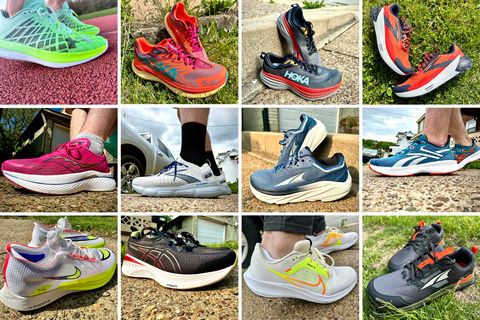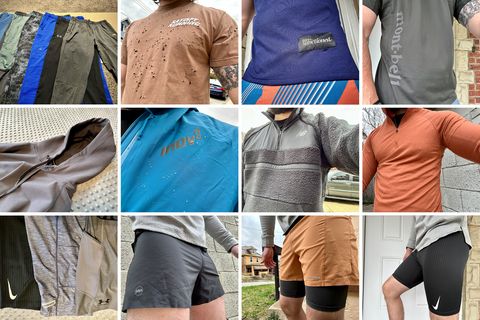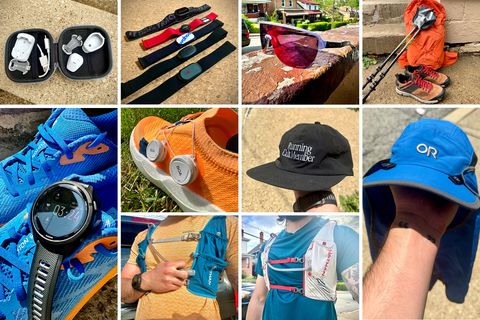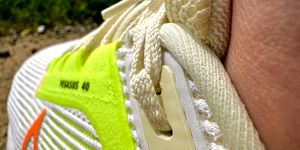When it comes to fitness disciplines, there are few more approachable than running. After all, there’s a reason roughly 15 percent of the United States population partook in some form of running or jogging on a consistent basis last year alone. Yet, while the general needs of the activity are intuitive at a glance — just shoes, some apparel and maybe a few accessories, right? — dig a little deeper and you’ll soon realize that finding the right equipment for the miles ahead can leave you spinning your wheels in a hurry.
Yes, the running gear rabbit hole is deep and cavernous with plenty of pathways to get lost in. Want a premium pair of running shoes? Well, you'd better know your gait type, intended terrain, desired speed, sensitivity to carbon plates, and a litany of other concerns. Want some apparel to match your new fitness interests? Be prepared to outline your typical workout conditions, sweat levels and more. And don’t get us started on wearables … that is, unless you want to slowly sink into madness trying to decipher which accelerometer is best for VO2 Max recordings, stride length measurements and other data metrics that are likely far beyond your athletic needs.
Despite the crowded landscape, though, finding the ideal running essentials doesn’t need to be a complicated endeavor. We’re constantly hitting the streets, trails and track lanes identifying well-to-do silhouettes across all running categories, so the heavy lifting (err, pacing) is done. Here’s a few tips on the top areas you should be focusing on when developing your first running kit, as well as some tips to help you zone in on worthwhile silhouettes along the way.
Start from the Ground Up — Literally
It should come as no surprise that the first piece of running equipment worth your time and energy should be the all-important running shoe. "Your feet are the primary piece of equipment for runners, so it pays to outfit them with high-quality gear," says Cory Smith, founder and head coach at Run Your Personal Best. As such, you’ll need to determine some goals you have in relation to your training. Understanding these aspirations first and foremost can help you filter out unnecessary profiles for an easier shopping experience.
Once you have a solid idea of your intended running goals, you can then move into finding a profile that’s best for your specific foot type. "It's worth investing in a shoe that really makes your foot feel good," advises Ashley Mateo, a running coach, marathoner, writer and gear tester. "Go to a running store, get properly fitted, get your gait analyzed and get a shoe that's going to support your body in the most efficient, comfortable way.”
Above all else, don’t let price points sway you into thinking that more expensive sneakers mean improved on-road performance. You’re still capable of getting in some solid workouts with budget-friendly dailies, provided their fitting to your individual footbed. Do the research first and find a profile that’s prime for your needs, price tags be damned.
Below are a handful of buying guides outlining a number of running shoe silhouettes best suited for a wide range of training needs and disciplines. From trusted daily trainers to race-ready speedsters, if you can think of a silhouette, odds are we’ve included it somewhere in these roundups:
- The Best Running Shoes Available Today
- The Best Neutral Running Shoes
- The Best Cushioned Running Shoes
- The Best Stability Running Shoes
- The Best Marathon Running Shoes
- The Best Trail Running Shoes
- The Best Barefoot Running Shoes
- The Best Winter Running Shoes
Keep Your Apparel Simple, Yet Performance-Minded
Moving onto running garments, a proper kit usually entails multiples of running-specific shirts and shorts, along with some key additions like athletic socks, compression shorts and running pants for those chillier routes in fall and winter. While this garb may seem similar to your trusty cotton tees or baggy shorts from gym classes past, today’s technology has led to improved fits, better moisture management and much improved style.
Now, you don’t have to raid your entire closet and swap out your wardrobe for solely performance-based picks, but having a few options for training days can help keep your mind at ease when jogging — and less stressed about routine laundry cycles. Plus, most quality silhouettes share similar fabric choices and cuts, so there’s no problem with mixing and matching your brand assortment if it means saving some coin in the buying process.
Due to our heightened interest in training and fitness, running garb has become a solid staple throughout our wardrobes. As such, we’ve worn enough tops, bottoms and other profiles to know which garments are worth their (light)weight. Below are some helpful running apparel roundups to make shopping for that new fitness look a breeze:
- The Best Running Shirts
- The Best Running Shorts
- The Best Running Pants
- The Best Athletic Socks
- The Best Compression Shorts
- The Best Workout Hoodies
- The Best Running Jackets
Accessorize Accordingly
Finally, when you’re adding running items to your cart, odds are you’re likely to peruse worthwhile accessories, too. Items like a running cap and pair of sunglasses are innocent enough, so feel free to find picks that suit your personal taste, but other items may be more enticing than necessary. One such example would be the ever-popular running watch. Sure, these wearables can provide you with a slew of metrics to help you analyze your performance, but is the tech really necessary?
According to Mateo, it’s not. "Yes, it's super fun to track everything from your VO2 max to altitude adjustment to vertical oscillation, but certain watches can run up to $900," she points out. "That's insane. If you must track, all you really need to know is your pace, distance and total time."
Admittedly, your humble author does utilize a running watch in our training habits, and occasionally pair the devices to premium heart rate monitors, as well, but we’re interested in the data and understand that numbers aren’t everyone’s cup of tea when it comes to fitness. Some athletes just want to get out and run…and that’s perfectly okay.
There are a number of other accessories to consider for your running kit, from hydration vests to running belts, condition-specific essentials and more. Below you’ll find a good mix of buying guides examining these options:
- The Best Running Caps
- The Best Running Sunglasses
- The Best Insoles for Training
- The Best Running Hydration Vests
- The Best Running Belts
- The Best Running Watches
- The Best Heart Rate Monitors
- The Best Running Earbuds
- The Best Nighttime Running Gear
- The Best Winter Running Gear
One Last Thing — Ignore the Hype
Above all else, running’s popularity is vast and wide — don’t think that the one shoe or top you constantly see advertised is the lone option you have. Additionally, just because your colleague or favorite social media follow recommended a certain silhouette doesn’t mean that the product will fit your training needs, too. "Don't buy anything just because someone else told you to buy it," Mateo concludes. "Running is so specific to the individual; your anatomy and mechanics are in no way comparable to another runner, so buying something just because of the hype is a huge mistake people make."
Running can be a fantastic experience for athletes, and getting started doesn’t need to be a taxing purchase process. Do your research, understand your needs and in the end, your kit will be the best it can be. Who knows, maybe you’ll unearth a product or brand even we haven’t discovered yet.






















